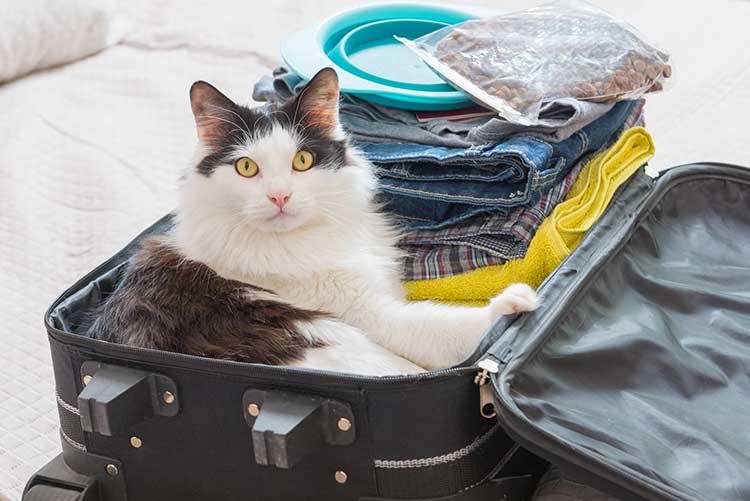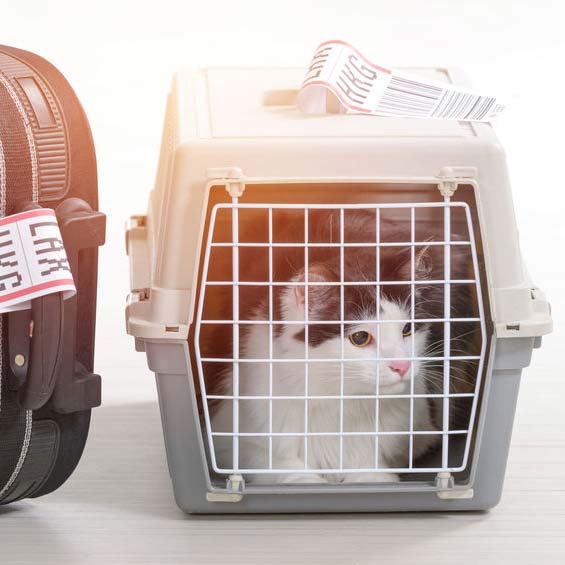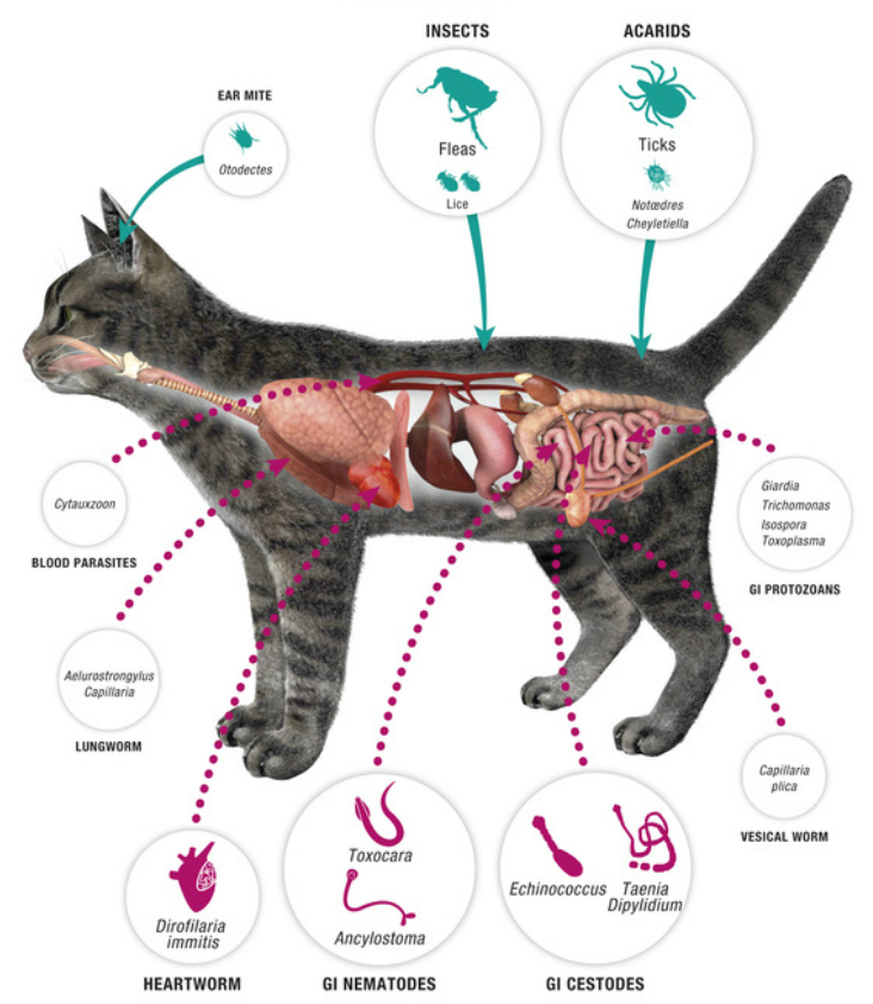Table of Contents
Traveling with a cat requires good planning
The cat boarding house is hopelessly overcrowded, the friendly neighbor has no time again, your own family lives far too far away, all your friends are on vacation. If you want to taking a trip with your cats, there are many reasons that can put you in an extremely difficult situation. Sometimes pet owners only have two alternatives: Either they forego the planned vacation and make themselves comfortable in their own four walls with their pet or they take your kitty, “just” goes on the trip.
As long as you stay in US and have a permanent residence for the entire vacation or business trip, taking your cat with you is not a real problem – provided that the owner of the holiday home has no objection to pets. On tours or stressful business trips, it is generally better not to take your pet with you. Traveling abroad can also prove to be difficult: strict entry regulations, current health certificates, meticulous vaccination certificates and a month-long quarantine make vacationing with your four-legged friend difficult. Of course, all of these regulations are probably sensible and well thought out; Ultimately, they also serve the health of all pets. However, they initially cause a whole range of inconveniences for the pet owner.

What needs to be done before you travel?
If you want to take your cat abroad with you, you should make inquiries long before you travel. Every veterinary office and also the ADAC can provide information about current entry regulations. Of course, you can also ask your vet, who can then carry out the necessary vaccinations that cat needs straight away. Don’t forget to ask whether cats are allowed where you are staying (hotel, holiday home, apartment)! You shouldn’t rely on the owner of your holiday home to give in once he looks into your cat’s charming eyes. Almost all hotels and holiday resorts insist on their house rules and generally do not make any exceptions.
Quarantine regulations
If you want to travel with your kitty, you should definitely find out about the entry regulations in the respective country. Some countries, have stricter regulations regarding the entry of cats. To prepare, the cats must spend some time in a quarantine station. You should really only accept this if you are planning to permanently move to the respective country. A stay of several weeks hardly justifies the hardships that a cat faces during the quarantine period. The quarantine stations are sterile and take no account of the needs of individual cats. Animals repeatedly die during the quarantine period and the animal owner’s options for action are reduced to a minimum, making the process an ordeal for humans and animals. The owner of the animal also bears the quarantine costs.
Rabies
An animal infected with rabies is expected to become ill within six months. Consequently, the disease would have to break out during the quarantine. Apparently, a later attack of the disease is not to be expected. Norway and Sweden also stuck to their quarantine regulations for many years. However, for five years now, traveling pet owners have finally been able to breathe a sigh of relief: the “compulsory detention” has been lifted. If you want to travel with your kitty, you still have to expect some complications in Norway and Sweden: Cats must not be younger than 1 month old and must undergo treatment against tapeworms in the last ten days before entry. In addition, the Scandinavians require a blood test that detects antibodies against rabies. The blood test must not have been carried out until four months after the rabies vaccination. The official veterinary health certificate must be issued within the last ten days before entry.

Entry regulations
In most countries it is sufficient to have an official veterinary health certificate that is not older than ten days and that the cat has been vaccinated against rabies within the last year. Vaccinations against cat flu, cat disease and leukosis should be a matter of course for every cat owner anyway. There is hardly a responsible cat owner who puts their pet at risk of catching an absolutely avoidable disease and possibly dying miserably from it.
Some countries, such as Finland, insist that the vaccine used is also approved in their country. The vaccination certificate must be issued (at least for entry into Finland) in German, English and Finnish or Swedish. In other countries, it is sufficient if the vaccination certificate contains explanations in three languages (English, German and French). Since entry regulations change frequently, you should find out about the current status as early as possible and immediately initiate all the necessary vaccination measures if you are planning a vacation with your four-legged friend. Anyone who relies on last year’s entry requirements to be the same as this year may be in for a nasty surprise and have their holiday plans thrown out of the window at short notice.
How do I transport my cat?
Once you have successfully completed all of these formalities, the second part of vacation planning follows: The cat must be kept in an escape-proof container during the trip. Disposable carrier prove to be an optimal alternative in this regard. They are easy to clean, completely escape-proof and they are comfortable to wear. Wicker baskets and soft fabric travel bags with air holes may be more attractive, but are far less suitable for long-term transport. Wicker baskets are extremely unwieldy and soft bags simply don’t offer the cat enough protection. Plastic kennels are suitable for traveling by car as well as for transport by plane and train. (If you are traveling with your kitties on the plane, you must inform the airline in good time that you are taking your cat with you! Any travel agency can provide information).

The travel equipment
Of course that belongs too cat waste box for a house cat’s travel equipment. You don’t necessarily need to take your local “large waste box” with you on vacation: a small, handy exhibition toilet is much more suitable for travel and also serves well in your vacation home. Cat litter, a litter scoop, plastic bags, cans of wet food , Dried animal food , treats , food and water bowls , To brush ,combs ,Cover,pillows, harness or restraint, carrier and you should also pack toys as a precaution. The usual types of food may not be available at the holiday destination or everything may be much more expensive than at home. Switching to an unfamiliar type of food could possibly be an additional burden. A cat’s metabolism adapts slowly to new food. – If you are planning a longer stay abroad, you should be careful with your cat’s stomach: changing your cat’s food habits should take at least a week. The proportion of usual food is slowly reduced; the proportion of new food increases in percentage terms. This gives the cat’s organism enough time to adjust to the new food.
During the travel
If you want to travel with your cats, you have to keep a few things in mind: Some cats can only tolerate being transported in a car to a limited extent. They react with severe nausea, are tense and very nervous. If your pet reacts by vomiting even on short journeys or is overly anxious, you should ease his condition. A veterinarian can certainly recommend a well-tolerated sedative that will put your four-legged friend into a gentle sleep for several hours.
Such a measure is definitely in the best interest of the animal and also allows the cat owner to start their vacation with less stress. Less sensitive cats can be calmed down by the mere presence of their caregivers and by good persuasion. But even if a cat likes to travel and is very confident in the car, you should never let it out of the transport box while driving. Cats that are not caged tend to climb all over the vehicle interior or distract the driver. Such experiments are unreasonable and pose a great danger to humans and animals. In the event of an accident, the cat is also much better protected in the transport box. If he sits unsecured in the back seat, he will be thrown through the driver’s cab in the event of heavy braking or a rear-end collision. Such an incident can cause a cat to panic, posing further danger to the occupants.
Traveling with cats: risk of heat stroke
If you travel south with your cat, you should keep an eye on the outside temperatures. High temperatures endanger the health of the cat and can cause heat stroke. If you are traveling in the car with your cats, the temperature should be comfortable during the journey – but drafts should be avoided. Caution is advised at gas stations and rest areas: Even if you just want to drink a coffee or plan a short break, the car must be parked in a shady place and the windows should be open a crack so that fresh air can get into the car. When exposed to direct sunlight, the interior of the vehicle quickly reaches threatening temperatures. If it is hot, the cat should be offered some water from time to time. A water bottle and a small plastic bowl serve well and are easy to use.

Infections and parasites
Every holiday destination has its pitfalls – at least when it comes to the spread of infectious diseases and parasites. Under certain circumstances, our cat may come into contact with pathogens abroad that are very rare in Austria and can cause serious illnesses. That’s why every trip abroad with your four-legged friend requires an intensive preliminary discussion with the veterinarian. He will point out possible risks, suggest prophylactic measures and give you tips on how to behave.
You should generally be wary of tap water: in some countries it is not of drinking water quality and this applies not only to us humans, but also to our pets. A cat can also be affected by intestinal bacteria and react with persistent diarrhea. Non-gas water bottles are available in most supermarkets and are a relatively safe alternative to tap water. Unlike dogs, most traveling cats will not enjoy independent exploration. It’s better this way: Contact with other animals, especially strays, can potentially lead to disease transmission.
Isn’t it the most beautiful place at home?
If you want to travel with cats, you need to be aware of certain risks and expenses. Of course, it is entirely possible to take your cat with you on vacation or on an urgent business trip. Some four-legged and two-legged friends obviously seem to enjoy such an adventure. However, before you start your journey, you should think carefully about whether there really is no other alternative. In general, cats prefer their usual territory and can easily cope with being separated from their caregivers for several weeks without suffering any lasting psychological damage. If you plan well in advance, you will certainly find a loving carer for your cat.
Traveling with cats: More tips
Cat-sitter clubs and animal shelters are also suitable contacts when it comes to temporarily boarding a cat. Some animal shelters have so-called “guest enclosures” that are separate from the other enclosures and can definitely be considered as an alternative. Addresses of cat-sitter clubs can be found in the telephone book, the Yellow Pages or in the vet’s waiting room.
“Luggage list” for the cat:
Basics
✓ Vaccination certificate
✓ Official veterinary health certificate
✓ Transport box
✓ Blankets and pillows
✓ Cat waste box
✓ Litter
✓ Spreading scoop
✓ Plastic bags
✓ Food and water bowls
✓ Wet and dry food
✓ Treats and vitamins
✓ Any medications required
✓ Brushes and combs
✓ Toys
✓ The telephone number of your own veterinarian
Essentials
Travel Carrier:
A sturdy and well-ventilated cat carrier is the foundation of safe travel. Choose one that provides enough space for your cat to stand, turn around, and lie down comfortably. Make sure it’s secure, with a reliable latch and good visibility.
Comfort Items:
Bring along familiar items to provide comfort and a sense of security for your cat:
- Favorite Blanket or Bedding: Familiar scents help ease anxiety.
- Favorite Toy: A familiar toy can provide entertainment and distraction during the journey.
Collar and Identification:
Ensure your cat wears a secure collar with an ID tag containing your contact information. In case of accidental escapes, proper identification is crucial for a safe return.
Harness and Leash:
For pit stops or outdoor exploration, a well-fitting harness and restraint allow your cat to stretch their legs while staying under your control.
Litter Box and Supplies:
- Portable Waste Box: Collapsible or travel-friendly waste boxes are convenient for on-the-go use.
- Litter: Choose a clumping or non-clumping variety that your cat is accustomed to.
- Waste Bags: Dispose of used waste responsibly.
Food and Water Essentials:
- Cat Food: Pack enough cat food for the duration of your trip, and bring a little extra in case of delays.
- Travel Bowls: Collapsible or compact bowls are easy to pack and essential for food and water breaks.
Health and Safety Essentials:
- Vet Records: Carry a copy of your cat’s recent health records, including vaccinations and any necessary medications.
- First Aid Kit: Include basic supplies such as gauze, antiseptic wipes, and any prescribed medications.
Window Screens or Sunshades:
Protect your cat from direct sunlight and keep them comfortable by using window screens or sunshades in the car.
Temperature Control:
- Climate-Appropriate Bedding: Ensure your cat is comfortable by providing bedding suitable for the weather.
- Climate Control in the Car: Maintain a comfortable temperature for your cat, avoiding extremes of heat or cold.
Entertainment:
- Interactive Toys: Keep your cat entertained during the journey with toys that engage their senses.
Grooming Supplies:
- Brush or Comb: Regular grooming helps keep your cat comfortable and reduces shedding.
- Nail Clippers: In case of any sharp claws that may need a trim.
Emergency Information:
- List of Emergency Contacts: Have a list of emergency contacts, including your vet and any pet-friendly emergency services along your route.
Conclusion:
By packing these essentials, you’ll be well-equipped for a smooth and enjoyable journey with your cat. Prioritize your cat’s safety, comfort, and well-being to ensure a positive travel experience for both of you. Remember that each cat is unique, so tailor your preparations to suit your cat’s specific needs and preferences. Safe travels!
FAQs
Q: Can I Travel with My Cat?
A: Yes, you can taking a trip with your cat, but it’s important to prepare and make sure your cat is comfortable during the journey.
Q: How do I Prepare my Cat for Travel?
A: You can prepare your cat for travel by getting them used to the carrier, making sure they are comfortable with car rides, and bringing along familiar items like their favorite blanket or toy.
Q: Is it Necessary to Use a Cat Carrier for Travel?
A: Yes, it’s essential to use a cat carrier for travel to ensure your cat’s safety and security during the journey.
Q: What Should I Put in the Cat Carrier for Travel?
A: When taking a trip with your cat, you should put their favorite blanket or bedding, some toys, and a familiar scent to keep your cat comfortable during the journey.
Q: How Can I Keep My Cat Calm During Car Travel?
A: To keep your cat calm during car travel, you can use products like Feliway, play calming music, and make sure your cat is comfortable in their carrier.
Q: Can I Leave My Cat Alone in the Car?
A: No, you should never leave your cat alone in the car, especially in extreme temperatures. It’s important to always bring your cat with you or find pet-friendly options when traveling.
Q: What Should I Do if My Cat Gets Anxious During Travel?
A: If your cat gets anxious during travel, you can try calming them with soothing words, providing treats, or talking to your veterinarian about options to keep your cat relaxed.
Q: How Often Should I Stop When Traveling with My Cat?
A: When taking a trip with your cat, it’s important to take regular breaks to allow your cat to stretch, use the litter box, and stay hydrated. The frequency of stops depends on your cat’s needs and the duration of the journey.
Q: Can I Travel Long Distances with My Cat?
A: Yes, you can travel long distances with your cat, but it’s essential to plan ahead, make sure your cat is comfortable, and consider their well-being throughout the journey.
Q: What Should I Consider Before Traveling with My Cat?
A: Before traveling with your cat, you should consider your cat’s temperament, their comfort with car rides, any special medical needs, and consult with your veterinarian to ensure a safe and pleasant travel experience for your feline friend.